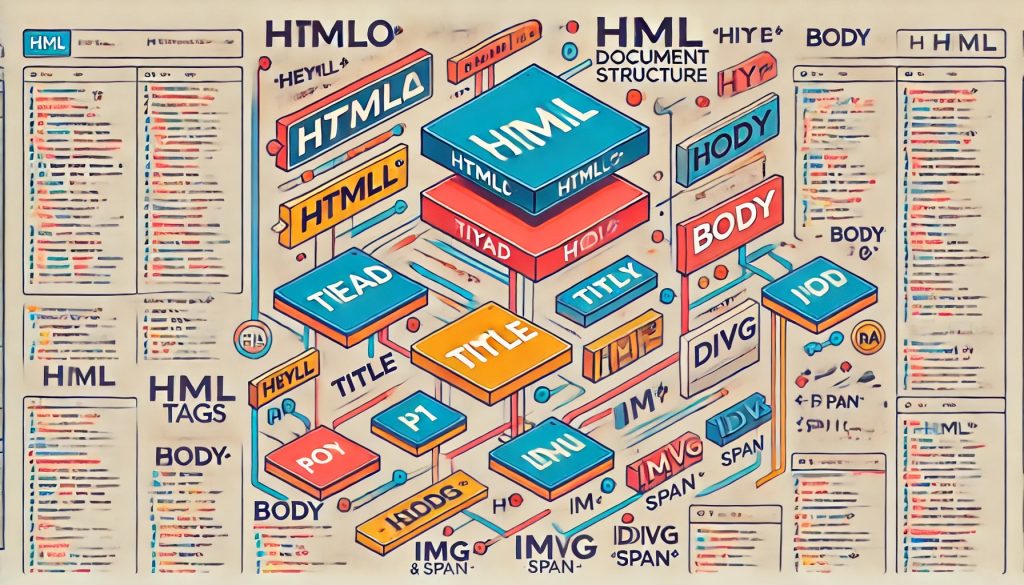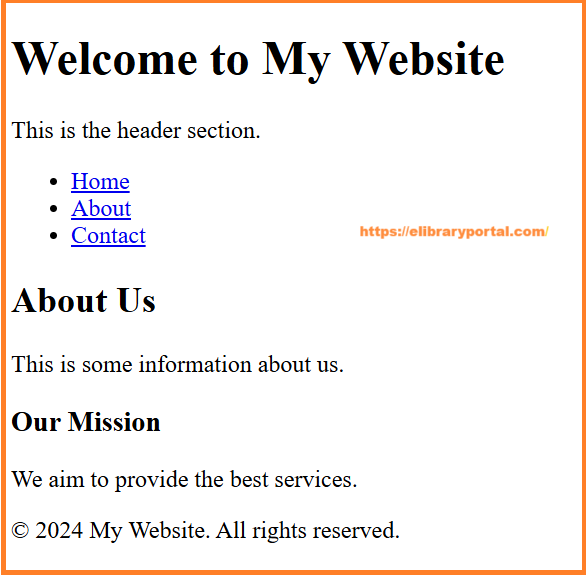HTML (HyperText Markup Language) tags and elements form the backbone of a webpage’s structure and layout. HTML is used to structure content on the web, including text, images, links, and forms. Here’s a breakdown of HTML tags, elements, and some commonly used examples:

1. HTML Tags
- Tags are keywords enclosed in angle brackets (
< >). Tags often come in pairs, an opening tag (like<tag>) and a closing tag (like</tag>), although some tags are self-closing. - Examples:
<p> ... </p>: Paragraph tag<h1> ... </h1>: Heading tag<img src="image.jpg" />: Image tag (self-closing)
2. HTML Elements
- An HTML element consists of a start tag, content, and an end tag.
- For example, in
<p>Hello, World!</p>,<p>is the start tag,Hello, World!is the content, and</p>is the end tag. - Elements can also contain other elements, creating a nested structure.
Basic Structure of an HTML Document
Here’s the basic layout of an HTML document with commonly used tags:
<!DOCTYPE html>
<html>
<head>
<title>Page Title</title>
</head>
<body>
<h1>This is a Heading</h1>
<p>This is a paragraph.</p>
<a href="https://rojgarbharat.info/">This is a link</a>
</body>
</html>
Common HTML Tags
- Document Structure Tags
<!DOCTYPE html>: Declares the document type as HTML5.<html>: Root element of an HTML page.<head>: Contains meta-information like the title and links to CSS.<title>: Sets the page title shown in the browser tab.<body>: Contains all the content to display on the webpage.
- Text Formatting Tags
<h1> to <h6>: Heading tags,<h1>is the largest,<h6>the smallest.<p>: Paragraph tag for blocks of text.<strong>: Bold text.<em>: Italic text.<br>: Line break (self-closing).<hr>: Horizontal line (self-closing).
- Link and Image Tags
<a href="URL">: Creates a hyperlink.<img src="URL" alt="description">: Embeds an image (self-closing).
- List Tags
<ul>: Unordered list.<ol>: Ordered list.<li>: List item (used inside<ul>or<ol>).
- Table Tags
<table>: Defines a table.<tr>: Table row.<td>: Table cell.<th>: Table header cell.
- Form Tags
<form>: Form container.<input>: Input field (self-closing).<label>: Label for input elements.<textarea>: Multi-line text input.<button>: Button for submitting forms.
- Div and Span Tags
<div>: Block-level container for grouping elements.<span>: Inline container for styling specific parts of text.
Nesting of Tags
HTML elements can be nested within each other, allowing complex layouts. For instance:
<div>
<h2>My Blog Post</h2>
<p>This is an interesting blog post.</p>
<a href="https://rojgarbharat.info/">Read more</a>
</div>
HTML Attributes
Tags can have attributes that provide additional information:
- Common attributes include
id,class,src,href,alt, andstyle. - Example:
<a href="https://rojgarbharat.info/" target="_blank">Visit Example</a>
HTML Tutorial Index
HTML Elements
- HTML Tags and Elements
- Nesting HTML Elements
- Block-level vs Inline Elements
- Empty (Void) Elements
HTML Document Structure
- The
<html>,<head>, and<body>Tags - Metadata:
<meta>,<title> - Linking External Files:
<link>
HTML Headings, Paragraphs, and Text Formatting
- Headings:
<h1>to<h6> - Paragraphs:
<p> - Line Breaks and Horizontal Rules:
<br>,<hr> - Text Formatting Tags:
<b>,<i>,<strong>,<em>,<mark>
HTML Links (Hyperlinks)
- Creating Links: The
<a>tag - Internal Links vs External Links
- Opening Links in New Tabs:
target="_blank" - Linking to Email or Phone Numbers
HTML Images
- Adding Images: The
<img>tag - Image Attributes:
src,alt,height,width - Responsive Images
- Image Formats and Optimization
HTML Lists
- Ordered Lists:
<ol> - Unordered Lists:
<ul> - Definition Lists:
<dl> - Nesting Lists
HTML Tables
- Basic Table Structure:
<table>,<tr>,<td>,<th> - Table Headers and Footers
- Merging Cells:
rowspan,colspan - Styling Tables with CSS
HTML Forms
- The Form Tag:
<form> - Input Types:
<input>,text,password,email,number, etc. - Form Controls:
<textarea>,<select>,<option>,<button> - Form Validation and Attributes
- File Uploads
HTML Multimedia
- Embedding Audio:
<audio>tag - Embedding Video:
<video>tag - Adding Captions and Subtitles
- Embedding YouTube Videos
HTML Semantics
- Semantic Elements:
<header>,<footer>,<article>,<section>,<aside>,<nav> - Importance of Using Semantic Tags
HTML5 New Features
- The New Input Types:
email,date,url,range - Geolocation API
- Canvas API: Drawing Graphics
- Local Storage and Session Storage
HTML Attributes
- Global Attributes
- The
idandclassAttributes styleand Inline CSStitleanddata-*Attributes
HTML Accessibility
- Adding
altText for Images - Using ARIA Attributes
- Best Practices for Accessibility
HTML Best Practices
- Writing Clean and Readable Code
- File Naming Conventions
- Organizing Project Files
- Comments and Documentation
HTML and CSS
- Linking CSS to HTML:
<link>,<style> - Inline, Internal, and External CSS
- Using CSS for Layout and Design
HTML and JavaScript
- Adding JavaScript:
<script> - Event Handling with HTML
- Using JavaScript for Interactivity
Responsive Web Design
- Meta Viewport Tag
- Mobile-First Design
- Media Queries
HTML Tools and Resources
- HTML Validators
- Browser Developer Tools
- Online Code Editors and Resources






